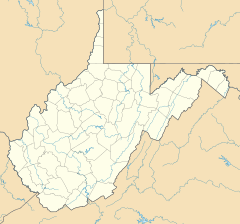Arroyo, West Virginia facts for kids
Quick facts for kids
Arroyo, West Virginia
|
|
|---|---|
| Country | United States |
| State | West Virginia |
| County | Hancock |
| Elevation | 686 ft (209 m) |
| Time zone | UTC-5 (Eastern (EST)) |
| • Summer (DST) | UTC-4 (EDT) |
| GNIS ID | 1535027 |
Arroyo is a small, quiet place in Hancock County, West Virginia, United States. It is known as an "unincorporated community." This means it doesn't have its own local government like a city or town. Instead, it's managed by the county.
Arroyo was once called Brooklyn. The name "Arroyo" comes from a nearby stream called Dry Creek. In Spanish, the word "arroyo" means "dry creek." This name tells us a little about the area's natural features.
Contents
What is an Unincorporated Community?
An unincorporated community is a group of homes or businesses that are not part of an official city or town. They don't have their own mayor or city council. Instead, the county government handles services like roads, police, and fire protection.
Why are some places unincorporated?
Many small communities start without formal city governments. As they grow, some might decide to become a city or town. Others, like Arroyo, remain unincorporated. This can be because they are very small or prefer county services.
Where is Arroyo Located?
Arroyo is found in the northern part of West Virginia. This state is in the Appalachian Mountains region of the United States. West Virginia is known for its beautiful mountains and forests.
Hancock County: Arroyo's Home
Arroyo is specifically located in Hancock County. This county is the northernmost county in West Virginia. It sits along the Ohio River, which forms part of the state's border.
Geography of the Area
The area around Arroyo, like much of West Virginia, has rolling hills and valleys. The mention of "Dry Creek" suggests that streams and waterways are part of the local landscape. The elevation of Arroyo is about 686 feet (209 meters) above sea level.
The Name "Arroyo"
The name "Arroyo" is interesting because it comes from the Spanish language. It means "dry creek" or "gully." This name was given because of a local stream called Dry Creek.
How places get their names
Many places get their names from local features. This could be a river, a mountain, or even a type of plant or animal. Sometimes, names come from the people who settled there or from historical events.



